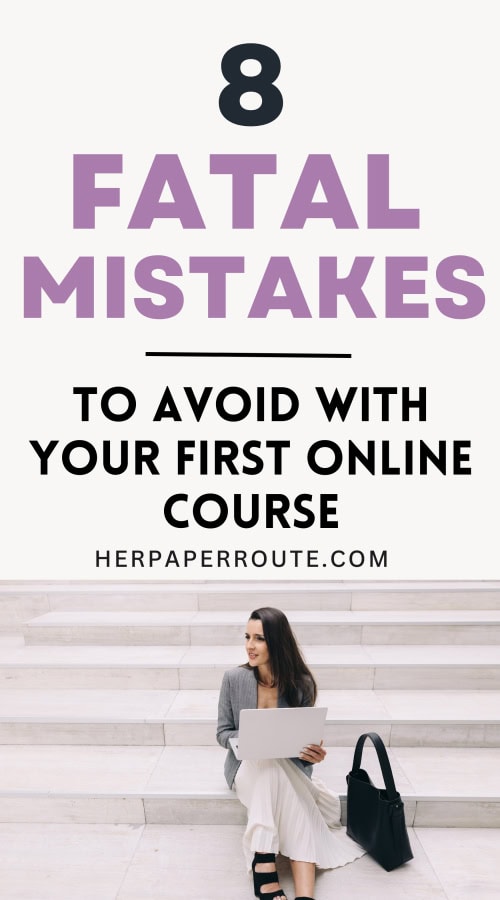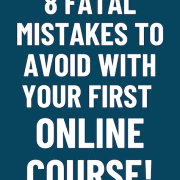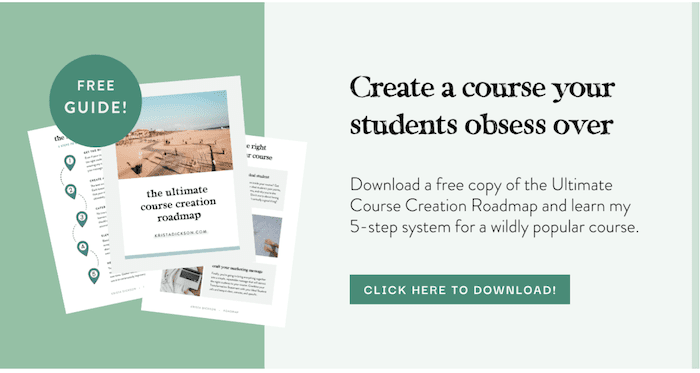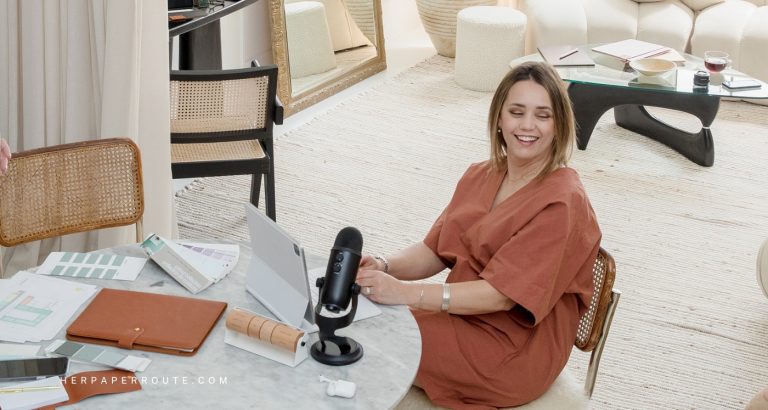8 Fatal Mistakes to Avoid With Your First Online Course

Launching your first course? I’m, going to help you avoid some costly mistakes at this stage. Have you heard the story of Krista’s very first course launch back in 2016?
In a nutshell, she spent six weeks creating the course material and pouring every spare second she had into it. But when she finally opened up her course for enrollment… crickets!
As an affiliate partner of various brands and sponsored content, HerPaperRoute may earn commission on qualifying purchases. Disclaimer
She ended up making 6 or 7 sales over the next couple of months, totaling around $1500 in revenue. When you deduct business expenses (she hired a copywriter and a designer to help her with my course) and income taxes, my profit was basically zero.
What went wrong, you ask?
Well, in her words, she said she simply didn’t have a clue what she was doing.
She created a good course, but she didn’t know how to sell it.
So today, I want to share some tips for you as you create your online course, so that you can avoid these mistakes.
And make your course launch a huge success!
But first you might be wondering, why courses?
3 reasons that online courses are my favorite way to make money online
Reason #1. Courses can generate passive income
A course is a resource that you create once and can then sell over and over again.
Unlike a 1:1 service, you don’t need to spend time every day working on your courses in order to continue generating revenue from them. Once the course is done, it’s done.
With the right launch strategy or sales funnel in place, your courses can bring in money every single day on autopilot without you lifting a finger.
Reason #2. With courses, you remove the cap on your income
When you work with clients 1:1, there are only so many people you can work at a time. Because hello, there are only 24 hours in a day!
But as a course creator, those time and income ceilings disappear. There’s no limit to the number of people you can serve with your course. And that’s a beautiful thing.
Reason #3. Courses are usually sold at a higher price point than smaller digital products
In other words, you need to sell less courses vs. other smaller products like ebooks or templates to make the same amount of money.
For example, if you have an ebook you sell for $20 and an e-course for $200 and you want to earn $5,000, you would need to either sell 250 ebooks or 25 courses.
Clearly, courses are awesome. I’m obviously a huge fan!
Now, let’s dive into 8 big mistakes to avoid when creating and launching your first course.
8 Mistakes to Avoid With Your First Course Launch

Mistake #1. Not validating your course idea
Picture this.
You spend months creating beautiful, valuable, actionable content to go inside your first online course.
You create a gorgeous sales page.
You schedule emails and social media to promote your course.
You finally make the announcement and open enrollment… and not a single person signs up during your launch.
YOUCH. That’s the last thing we want to happen!
And the biggest reason I see course creators making zero sales is that they didn’t validate their course idea ahead of time.
Before you spend your precious time creating a course, you need to know that:
a) Your audience is excited about the topic of your course and sees the value in it
b) Your audience is willing to pay for the knowledge and results your course provides
How to fix this mistake
Before creating your online course, you need to validate your idea by pre-selling the course to your audience.
In other words, I want you to open up enrollment and start selling your course before you’ve actually put the course content together.
Essentially, pre-selling gets your audience to “put their money where their mouth is” and ensures that it’s worth your time to move forward and create the course.
To run a successful pre-sale for your course, all you need is:
1. A killer sales page (more on sales pages in a bit).
2. An outline of what you’ll teach inside the course.
3. To let your customers know that the course hasn’t been created yet but it will be ready on X date.
During the pre-sale, you’ll share the course with your mailing list, promote it in a blog post, promote it on your social media accounts, and see whether the topic is a profitable fit for your audience.
If you make sales during the pre-sale period, you’re good to go and can start creating the course content for your students.
Mistake #2. Your course doesn’t meet your audience where they’re at
Here’s the thing.
A lot of the time we want to create a course on a topic that we’re passionate about, which is totally fair.
But if your course isn’t created with your audience in mind, you’ll probably have a hard time selling it.
Now, what exactly do I mean by “meeting your audience where they’re at”?
I mean that if your audience is full of total beginners, don’t create a super-advanced course and try to sell it to them.
And vice versa. If a large portion of your audience is already at an intermediate or advanced level, a beginner-friendly course probably won’t interest them.
How to fix this mistake
You need to get to know your audience and understand what level they’re at when it comes to the topic of your course.
You can do this by chatting with your readers 1:1, running polls on social media (Instagram polls are my fave), or sending a questionnaire to your mailing list.
Once you know where your audience is at and the point they want to get to, you can create a course that meets their needs.
Mistake #3. You haven’t established yourself as an expert
People don’t want to buy courses from just anyone.
If your audience members are shelling out their hard-earned pennies on your course, it’s because they view you as an expert and trust in your ability to help them achieve results.
If nobody’s buying, it might be because they don’t view you as an expert in your niche.
How to fix this mistake
Before opening your course for enrollment, spend at least 3-4 weeks establishing yourself as an expert on the topic of your course. This can be done through:
-
Sending educational emails to your mailing list on a weekly basis
-
Publishing a blog post or podcast episode every week
-
Showcasing your knowledge by sharing tips on social media
-
Sharing inspirational content with your audience where you highlight the results and successes you, your clients, and your readers have had
When you’ve successfully built up your status as an expert, you’re ready to announce your course and start pre-selling it.
Mistake #4. Your course doesn’t promise a specific result
Here’s my golden rule when it comes to creating courses:
Good courses are actionable and should help your students achieve a specific result.
Your course shouldn’t just be knowledge-vomit.
In other words, don’t cram every single thing you know into your course and expect people to wade through and pick out the information that’s relevant to them.
How to fix this mistake
Instead of trying to include everything you know about the topic in your course, start by choosing a clear and concrete result you’ll help your students achieve.
Next, come up with a step-by-step process or system to take your students from Point A (where they are now) to Point B (the result you’re promising).
For example, instead of creating a course called “Yoga for Beginners”, which is pretty vague and could include a million different things, why not create a course called “How to Master Yoga Headstands in 30 Days”?
See how the latter promises a specific result and has a time limit? That’s course promise perfection right there.
For your first course, I suggest focusing on one specific result you can help your students achieve.
Don’t promise the world and then fail to deliver!
Hone in on the one big thing your audience is dying to learn or accomplish, and then center your course around helping them achieve that goal or result.
Mistake #5. You released your course with no build-up
One creator says of her first course launch “For some reason, I had it in my head that I had to keep my course a secret and do this big reveal on cart open day.”
…Ummm, what? Not a very smart strategy.
People need to know about your course long before you open the cart for enrollment.
In a perfect world, you want your audience to be marking the date on their calendars and counting down the days until they can join. So don’t keep your readers in the dark!
How to fix this mistake
This is where a detailed pre-launch strategy comes into play.
For 3-4 weeks prior to opening your course for enrollment, your main goal should be to get people excited and hyped up about your course.
I repeat: Don’t keep it a secret!
You don’t need to reveal all the details just yet. For example, you can keep things like the curriculum and the price under wraps.
With that said, you should give your audience enough information to pique their interest and get them thinking about purchasing your course when you open enrollment.
Here are a few ways to build hype during your pre-launch phase:
1. Start a countdown on social media 7 days prior to the course opening
2. Share behind-the-scenes peeks of you working on the course and materials
3. Share success stories from you, your readers, and your clients
For more tips on running a successful pre-launch campaign, check out this post!
Mistake #6. You’re focused on creating the course and don’t have a plan for selling it
Anna says:
“When I created my first course, not only did I not pre-sell it ahead of time, I also let myself get so wrapped up in putting together the course material that I barely stopped to think about my sales strategy. I had a sales page and a blog post ready to go, and that was pretty much it.”
Don’t make Anna’s mistake!
Putting together a solid launch strategy should be your biggest focus when creating and launching your first course.
How to fix this mistake
During your pre-launch phase, you’ll want to create a well-thought-out, in-depth sales plan for your course.
Your launch strategy should include:
1. Your sales page
2. 5-7 emails you send to your list during the cart open period
3. Social media images and copy you’ll share during the launch
4. Any blog posts you’ll publish about the course
5. A lead magnet to attract relevant leads before your launch
Don’t overlook what happens before you open your course for enrollment.
Building excitement before a launch is how you guarantee sales once you open the cart.
Mistake #7. Your sales page isn’t persuasive enough or it doesn’t hit on the right points
Sales pages are tricky to get just right but I do think that practice makes perfect.
Each new sales page you write will be 10x better than your last one, trust me.
You may think that you need to hire a copywriter.
But instead of paying someone to tidy up your words, you should actually invest in a resource that will teach you the key elements to include on your sales page, how to write persuasively, and what order to place everything in.
Yep – we teach you all of this inside the HerPaperRoute Society.
How to fix this mistake
To ensure your sales page is primed to get people buying, don’t rush the process
. If you need to, purchase a template or get help from a copywriting expert — it’ll be worth it in the long run.
Mistake #8. You don’t send enough emails about your course
Look, I get it.
We’ve all been on the receiving end of a bajillion emails when someone launches a new course or product.
And yes, it can be a bit annoying if you’re not interested in that person or their course.
But don’t let this deter you. And please don’t think you should only send 1 or 2 emails to your subscribers during your launch!
Think of it this way. You deliver so much free value to your subscribers in your weekly blog posts, your emails, and your social media posts.
Now you’ve spent weeks or even months working on your course and launch strategy.
Girl — this is your time to shine!
How to fix this mistake
I recommend you send a minimum of 5-7 emails to your mailing list during your open cart period (which lasts roughly 7-10 days).
Don’t let that number scare you. Just focus on delivering value with each email you send and share your course with pride.
If this still makes you uncomfortable, you can include a link in your sales emails that your subscribers can click on to opt-out of hearing about the course.
Here are some ideas for emails you can send your list during your course launch:
1. An email introducing the course and explaining who it’s a good fit for
2. An email sharing client testimonials or your own results
3. Frequently Asked Questions
4. An email introducing a special 24-hour or 48-hour bonus
5. A last chance email (or two) on the day the cart closes
Yes, if you send multiple emails every day during your launch, some people will unsubscribe from your list.
But people unsubscribe anyways, even if you only email them once a week or even once a month. Don’t take it personally.
It just means that person wasn’t a good fit for you and your offerings, and in that case, you’re better off without them on your list anyway.
Mistakes to Avoid With Your First Online Course – Conclusion
Have you launched a course before?
Did you make any of the mistakes above? Let me know what other questions you have about courses down below!
And before you go, make sure you grab your free copy of our Course Creation Roadmap!

Follow along on Instagram!







![How To Create An Online Course [Ultimate Guide] 9 the ultimate guide on how to create an online course for successful creators](https://herpaperroute.com/wp-content/uploads/2017/12/the-ultimate-guide-on-how-to-create-an-online-course-for-successful-creators-768x410.jpg)



